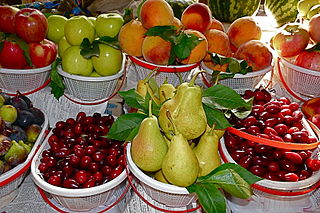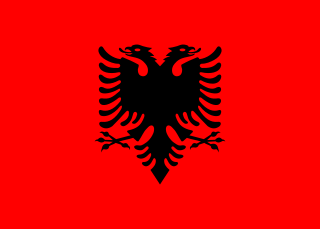A State farm or Soviet farm, is a state-owned farm. The term originated in the Soviet Union, hence the name.

Agriculture in the Soviet Union was mostly collectivized, with some limited cultivation of private plots. It is often viewed as one of the more inefficient sectors of the economy of the Soviet Union. A number of food taxes were introduced in the early Soviet period despite the Decree on Land that immediately followed the October Revolution. The forced collectivization and class war against "kulaks" under Stalinism greatly disrupted farm output in the 1920s and 1930s, contributing to the Soviet famine of 1932–33. A system of state and collective farms, known as sovkhozes and kolkhozes respectively, placed the rural population in a system intended to be unprecedentedly productive and fair but which turned out to be chronically inefficient and lacking in fairness. Under the administrations of Nikita Khrushchev, Leonid Brezhnev, and Mikhail Gorbachev, a large number of reforms were enacted as attempts to defray the inefficiencies of the Stalinist agricultural system. However, Marxist–Leninist ideology did not allow for any substantial amount of market mechanism to coexist alongside central planning, so the private plot fraction of Soviet agriculture, which was its most productive, remained confined to a limited role. Throughout its later decades the Soviet Union never stopped using substantial portions of the precious metals mined each year in Siberia to pay for grain imports, which has been taken by various authors as an economic indicator showing that the country's agriculture was never as successful as it ought to have been. The real numbers, however, were treated as state secrets at the time, so accurate analysis of the sector's performance was limited outside the USSR and nearly impossible to assemble within its borders. However, Soviet citizens as consumers were familiar with the fact that foods, especially meats, were often noticeably scarce, to the point that not lack of money so much as lack of things to buy with it was the limiting factor in their standard of living.
Agriculture in Russia survived a severe transition decline in the early 1990s as it struggled to transform from a command economy to a market-oriented system. Following the breakup of the Soviet Union in 1991, large collective and state farms – the backbone of Soviet agriculture – had to contend with the sudden loss of state-guaranteed marketing and supply channels and a changing legal environment that created pressure for reorganization and restructuring. In less than ten years, livestock inventories declined by half, pulling down demand for feed grains, and the area planted to grains dropped by 25%.
The Five-Year Plans of Vietnam are a series of economic development initiatives. The Vietnamese economy is shaped primarily by the Vietnamese Communist Party through the plenary sessions of the Central Committee and national congresses. The party plays a leading role in establishing the foundations and principles of communism, mapping strategies for economic development, setting growth targets, and launching reforms.

Agriculture in Belarus is a shrinking sector of the Belarusian economy. The share of agriculture in GDP declined from 11.6% in 2000 to 7.4% in 2007, while the share of agriculture in total employment dropped from 14.1% to 9.9% over the same period. The decrease in agricultural employment is a long-term trend and back in the early 1990s agriculture's share was as high as 19% of the number of employed. The decrease of agricultural labor parallels the general urbanization trends, as the share of rural population in Belarus steadily declines over time.
A CPA, or Agricultural Production Cooperative, is a type of agricultural cooperative that exists in Cuba today.
In the Hungarian People's Republic, agricultural collectivization was attempted a number of times in the late 1940s, until it was finally successful in the early 1960s. By consolidating individual landowning farmers into agricultural co-operatives, the Communist government hoped to increase production and efficiency, and put agriculture under the control of the state.

Agriculture in Mongolia constitutes over 10% of Mongolia's annual Gross domestic product and employs one-third of the labor force. However, the high altitude, extreme fluctuation in temperature, long winters, and low precipitation provides limited potential for agricultural development. The growing season is only 95 – 110 days. Because of Mongolia's harsh climate, it is unsuited to most cultivation. Only 1% of the arable land in Mongolia is cultivated with crops, amounting to 1,322,000 hectares in 1998. The agriculture sector therefore remains heavily focused on nomadic animal husbandry with 75% of the land allocated to pasture, and cropping only employing 3% of the population. Crops produced in Mongolia include corn, wheat, barley, and potatoes. Animals raised commercially in Mongolia include sheep, goats, cattle, horses, camels, and pigs. They are raised primarily for their meat, although goats are valued for their hair which can be used to produce cashmere.

Armenia has 2.1 million hectares of agricultural land, 72% of the country's land area. Most of this, however, is mountain pastures, and cultivable land is 480,000 hectares, or 16% of the country's area. In 2006, 46% of the work force was employed in agriculture, and agriculture contributed 21% of the country's GDP. In 1991 Armenia imported about 65 percent of its food.

Georgia’s climate and soil have made agriculture one of its most productive economic sectors; the 18 percent of Georgian land that is arable provided 32 percent of the republic's NMP in 1990. In the Soviet period, swampy areas in the west were drained and arid regions in the east were salvaged by a complex irrigation system, allowing Georgian agriculture to expand production tenfold between 1918 and 1980. Production was hindered in the Soviet period, however, by the misallocation of agricultural land such as the assignment of prime grain fields to tea cultivation and excessive specialization. Georgia’s emphasis on labor-intensive crops such as tea and grapes kept the rural work force at an unsatisfactory level of productivity. Some 25 percent of the Georgian work force was engaged in agriculture in 1990; 37 percent had been so engaged in 1970. In the spring of 1993, sowing of spring crops was reduced by onethird on state land and by a substantial amount on private land as well because of fuel and equipment shortages. For the first half of 1993, overall agricultural production was 35 percent less than for the same period of 1992.
The problem of land reform in Ethiopia has hampered that country's economic development throughout the late 19th and 20th centuries. Attempts to modernize land ownership by giving title either to the peasants who till the soil, or to large-scale farming programs, have been tried under imperial rulers like Emperor Haile Selassie, and under Marxist regimes like the Derg, with mixed results. The present Constitution of Ethiopia, which was put into force January 1995, vests land ownership exclusively "in the State and in the peoples of Ethiopia." The relevant section continues, "Land is a common property of the Nations, Nationalities and Peoples of Ethiopia and shall not be subject to sale or to other means of exchange." Despite these different approaches to land reform, Ethiopia still faces issues of sustainable food self-sufficiency.

Like the rest of the economy, agriculture in Estonia has been in great flux since the degeneration of the collective and state farm systems.
Prior to World War II, agriculture in Bulgaria was the leading sector in the Bulgarian economy. In 1939, agriculture contributed 65 percent of Net material product (NMP), and four out of every five Bulgarians were employed in agriculture. The importance and organization of Bulgarian agriculture changed drastically after the war, however. By 1958, the Bulgarian Communist Party (BCP) had collectivized a high percentage of Bulgarian farms; in the next three decades, the state used various forms of organization to improve productivity, but none succeeded. Meanwhile, private plots remained productive and often alleviated agricultural shortages during the Todor Zhivkov era.
Despite six years of crisis in Syria, agriculture remains a key part of the economy. The sector still accounts for an estimated 26 percent of gross domestic product (GDP) and represents a critical safety net for the 6.7 million Syrians – including those internally displaced - who still remain in rural areas. However, agriculture and the livelihoods that depend on it have suffered massive loss. Today, food production is at a record low and around half the population remaining in Syria are unable to meet their daily food needs.

Agriculture in Venezuela has a much smaller share of the economy than in any other Latin American country. After the discovery of oil in Venezuela in the early 20th century to the 1940s, agriculture has declined rapidly, and with the beginning of large-scale industrial development in the 1940s, agriculture and land reform was largely neglected by successive governments. Since 1999, under the Bolivarian Revolution of President Hugo Chávez, agriculture has had a somewhat higher priority. Agriculture in Venezuela accounts for approximately 3% of GDP, 10% of the labor force, and at least a quarter of Venezuela's land area.
Agrarian reform and land reform have been a recurring theme of enormous consequence in world history. They are often highly political and have been achieved in many countries.
Collective farming and communal farming are various types of "agricultural production in which multiple farmers run their holdings as a joint enterprise". That type of collective is often an agricultural cooperative in which member-owners jointly engage in farming activities. The process by which farmland is aggregated is called collectivization. In some countries, there have been state-run and cooperative-run variants. For example, the Soviet Union had both kolkhozy and sovkhozy, often denoted in English as collective farms and state farms, respectively.
Land reform in Vietnam began in the political turmoil following World War II in which a civil war pitted the communist Viet Minh against the French colonists and their supporters. At that time a large percentage of agricultural land was owned by large landowners and the majority of the rural population of Vietnam owned only small plots of land or was landless. The early success of the land reform program of the Viet Minh, gave the communists a strong base of support among the 80 percent of the Vietnamese people who lived in rural areas. The support of the communists by a large number of rural dwellers was an important factor in determining the outcome of the Vietnam War.











